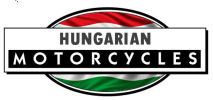



Notes on some of the lesser-known Hungarian marques
This page lists brands for which we currently have only an historical precis.
For a more complete listing visit the Hungarian Index.
Cyclon
Manufactured by Cyklon-Hungaria K.F.T. at Pf. 16, Berettyoujfalu, Hungary in 1993-94 and 1997-2000.
These were essentially Velosolex machines, and were exported to France, the United States and elsewhere. Production was taken over by Impex (VSF) in 1994, returned to KFT in 1997, and then went back to Impex around 2001.
The story is told in some detail at briansolex.free.fr
Duna Sidecars 1950s-1970s
Gaia
The Gaia began as a homebuilt during a period when it was nigh on impossible to develop a project in Hungary. After some decades it grew into a fine business building quality machines powered by Malaguti and Franco Morini engines.
For more information visit gaiamotors.hu
Source: Article at magyarjarmu.hu by Pál Négyesi
Gujdar
Manufactured by József Gujdár in Kispesten, Budapest, 1923
A bicycle attachment engine produced in very small quantities, it was very easy to fit and remove. There is a record of a 198cc Gu-Jo engine used in competition in 1929 by a family member.
Source: Article at magyarjarmu.hu by Pál Négyesi
Karwies
Manufactured by Károly Wiesner of 9 Csåky Street, Budapest, in 1927 and 1928. Only a handful of the Karwies 3-kerekü motoros were produced.
The firm produced other products including sanding machines, and also sold the similarly constructed Steigboy .
Source: magyarjarmu.hu
Robix
Manufactured by Robix Mezőgazdasági Gépgyártó Vállalat, 1986~1991.
Designed by József Czerny, this was a 3-wheel minicar powered by an electric motor. Numerous versions were explored including golf buggies and factory carts, but attempts at finding an export market were unsuccessful as it seems the electric motor was just not up to the task. The venture ceased in 1990 or 91.
Source: smallcarsclub.com
Schi-Ker 1921
Stadler Mihály
This motorcycle was exhibited at the 1939 Budapest International Fair. Similar to the Zunda in appearance, it was built at the former Zundapp Hungary factory and ran a 250cc JLO engine.
Source: Article at magyarjarmu.hu by Pál Négyesi
WMB
Manufactured by Manfréd Weiss on Csepel Island, Danube, Budapest.
The name is derived from Weiss, Manfred, Budapest.
Built shaft-drive boxer twins similar to those by BMW, and two-strokes of 100 and 125cc until 1939. After the war the company became Csepel.
See Manfréd Weiss